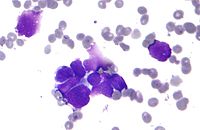
Photo from wikipedia
ObjectivesWhen induction therapy followed by surgery for locally advanced non-small cell lung cancer results in pathological complete response, the prognosis is excellent; however, relapses can occur. We analyzed the predictive… Click to show full abstract
ObjectivesWhen induction therapy followed by surgery for locally advanced non-small cell lung cancer results in pathological complete response, the prognosis is excellent; however, relapses can occur. We analyzed the predictive factors for achieving pathological complete response and reviewed the clinicopathological features and surgical outcomes of locally advanced non-small cell lung cancer with pathological complete response.MethodsBetween March 2005 and January 2015, 145 resections after induction therapy for locally advanced non-small cell lung cancer were performed; 38 cases achieved pathological complete response. Predictive factors for achieving pathological complete response were analyzed, and the clinicopathological features and surgical outcomes of 38 cases with pathological complete response were retrospectively reviewed.ResultsOf 145 patients, 98 underwent induction chemoradiation and 47, induction chemotherapy. Squamous cell carcinoma occurred most frequently (n = 64), followed by adenocarcinoma (n = 53). Only squamous cell carcinoma was positively associated with achieving pathological complete response (p = 0.009). Of 38 patients with pathological complete response, 33 were men and the mean age was 67.0 ± 6.3 years; the clinical stages were IIA (n = 3), IIB (n = 2), IIIA (n = 26), and IIIB (n = 3). One patient died within 30 days post-surgery (2.6%). Eight recurrences occurred during the follow-up period; brain metastasis occurred most frequently. The 5-year overall and recurrence-free survival rates were 79.5% and 72.6%, respectively.ConclusionsSquamous cell carcinoma was identified as a positive predictive factor for achieving pathological complete response. Among patients undergoing lung cancer surgery after induction therapy with pathological complete response, brain metastasis occurred most frequently.
Journal Title: General Thoracic and Cardiovascular Surgery
Year Published: 2019
Link to full text (if available)
Share on Social Media: Sign Up to like & get
recommendations!